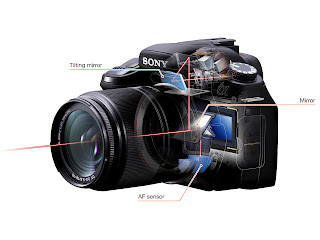
Try recollecting when you clicked a photograph! You might have clicked many , but have you really thought about what actually happens inside your camera when you hit the ‘CLICK’ button? Well, it’s as simple as 'Say Cheese'!
You might have been bewildered when the top row people’s foreheads in a group photograph were cut off, despite all your efforts in centering it. Well, here’s the reason why… Your Viewfinder, obviously being located above the lens of the camera, has a different optical path than that of the lens. So, speaking in a very microscopic scale, if you are focusing from your viewfinder on 1, 2, 3, 4… written on a number line, vertically downwards, your lens actually pictures the number line only from 2, 3, 4, 5…! To minimize this difference in the optical path from the viewfinders and lenses, the viewfinders are focused slightly downwards at an angle so that the two paths meet after a considerable distance. This is okay as long as you are taking a distant shot. But a close up shot framed in the viewfinder may not be the same image formed on the lens.
To minimize this difference in the optical path from the viewfinders and lenses, the viewfinders are focused slightly downwards at an angle so that the two paths meet after a considerable distance. This is okay as long as you are taking a distant shot. But a close up shot framed in the viewfinder may not be the same image formed on the lens.
 To minimize this difference in the optical path from the viewfinders and lenses, the viewfinders are focused slightly downwards at an angle so that the two paths meet after a considerable distance. This is okay as long as you are taking a distant shot. But a close up shot framed in the viewfinder may not be the same image formed on the lens.
To minimize this difference in the optical path from the viewfinders and lenses, the viewfinders are focused slightly downwards at an angle so that the two paths meet after a considerable distance. This is okay as long as you are taking a distant shot. But a close up shot framed in the viewfinder may not be the same image formed on the lens.We have two major types of cameras which are the SLR (Single Lens Reflex) Cameras and the Non-SLR Cameras. The SLR Cameras which record the image on an electronic imaging sensor to produce a digital image are the DSLR (Digital Single Lens Reflex) Cameras. I've restricted myself to only DSLR Cameras.
The DSLR camera, through a series of mirror and prism reflections allows the photographer to see what exactly is being captured by the imaging system. So actually, in these cameras you’re actually seeing the objects literally through the lens and not through a hole made above the lens like in the Non-SLR cameras.
So here’s how it is built. There’s a mechanical mirror fixed behind the camera lens to intercept the light rays emerging from the lens. This mirror reflects the light rays upwards by 90 degrees and sends them into a Five-sided-Prism (Pentaprism). The light rays undergo Total Internal Reflection twice inside the prism and finally comes out as the image in the eyepiece. When an image is taken, the mirror moves upwards allowing the light rays to fall on the focal place shutter, the aperture narrows, the shutter opens, projecting the image on the image sensor, and then photograph is captured. The mirror then snaps back into its position as the shutter closes.

The period of time where the mirror is flipped up is known as the VIEWFINDER BLACKOUT. All of this happens quickly over milliseconds and cameras can do this flipping action of the mirror nearly 8 times in a second.
Just because the word Digital comes in the acronym DSLR, dont mistake it to any other digicam! In digicams, the live view can be seen through the LCD as well as through the viewfinder simultaneously. But in DSLR cameras, you cannot get a live view in the LCD and all the viewing is done only through the optical viewfinder.
But, recent technological developments have enabled the newer DSLR Cameras to use either the optical view finder or the LCD as live view when composing the picture, although using both simultaneously isn’t yet achieved. The LCD Display has a one-up in cases where holding the camera to one’s face to look through the viewfinder is not possible and also in cases of Underwater Photography where the camera is wrapped in a plastic waterproof jacket. OLYMPUS introduced the first DSLR Camera with live preview, back in the year 2000. Canon, Nikon, Sony, Samsung and other models also started releasing models with live previewing as an option recently in the year 2008.

And yeah, DSLR Cameras are mainly popular for their provision of changing the lens for appropriate photography. It also allows you to attach specialized lenses. Usually photographers use lenses of the same brand as that of the camera. But there are some independent lens manufacturers like Vivitar, Sigma Tokina to name a few, which make a variety of lens mounts which are compatible with other brand cameras.
Agreed, DSLR cameras are any day better than the NON-DSLR cameras, but they aren’t low-priced. DSLR cameras range from Rs. 24,000 to 41,000.

Unless you aren’t into professional photography and you just want to catch that hind-stand your dog did or your class reunion’s pictures, a conventional point-and-shoot camera is good enough. A little gauging and practice while taking your snaps will definitely yield surprising results. Do keep those worthy moments CLICKED!
Feel free to post comments. All pictures were downloaded from Google.